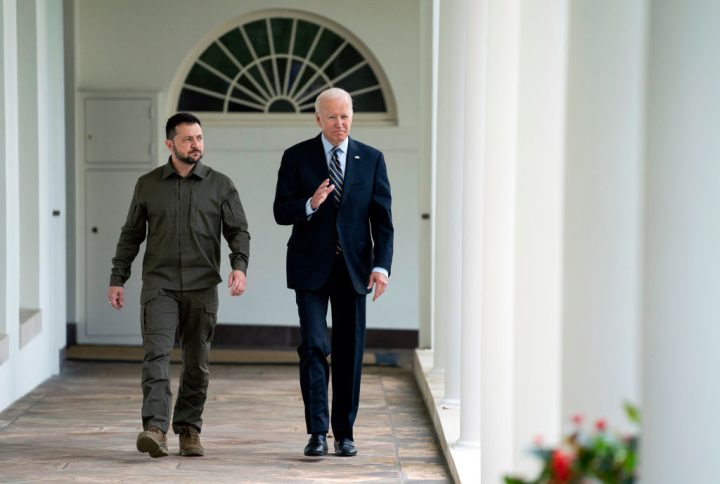Pranked by a Kremlin-friendly comedy duo, Italy’s Prime Minister, Giorgia Meloni, spoke for many when she confessed her ‘fatigue’ with the war in Ukraine. But there is some bad news for all the Europeans ‘tired’ of the conflict. Europe’s real job will only begin when the current war of attrition eventually congeals along more or less static lines, with or without a formal armistice.
The task ahead will not only involve physical reconstruction, budget support, or bringing Ukraine closer to EU membership. Much more importantly, it will involve guaranteeing the stability of whatever formal or informal settlement arises from the war.
The prospect of a sizeable US deployment in post-war Ukraine remains as distant as its Nato membership
The unfortunate reality is that US assistance to Ukraine is becoming an increasingly tougher political sell, especially under the leadership of the new Speaker of the House of Representatives, arch-MAGA Republican Mike Johnson. Even if most of the US’s military ‘aid’ to Ukraine is spent in the United States replenishing the Pentagon’s arsenal with new US-made weapons systems, the world would be lucky to see even one modest supplemental bill actually intended for Ukraine between now and the end of the current congress. Once the fighting stops, or even becomes less intense, making the political case for buttressing Ukraine’s defences or its budget with US resources is bound to become an impossibility.
Neither will the United States be of much help in getting Ukraine into the EU. More importantly, it probably won’t do much to help the country complete the domestic reforms necessary for accession that will make the Ukraine of the future look like Estonia or Poland.
Finally, and perhaps more chillingly for Kyiv, it seems unlikely that the United States will be there to underwrite Ukraine’s security and territorial integrity – unless doing so takes the form of yet another worthless ‘Budapest memorandum’. At the Nato summit in Vilnius this year, the Biden administration showed little interest in bringing Ukraine into the alliance, which would provide a sufficient deterrent to future Russian attacks. Should Donald Trump be re-elected, Nato’s enlargements would become even more unlikely – if anything, the future of the alliance itself would be on the line.
Perhaps a fully-armed Ukraine can deter future Russian invasions – but maybe not. If Russia rebuilds and modernises its forces and militarises its full manpower (which the Kremlin has thus far avoided), it may well be tempted to give Putin’s war of conquest a second chance.
What options are left? Since the end of the Korean War in 1953, the United States has kept a sizeable force in the South to deter North Korea’s aggression. Seven decades in, almost 30,000 US troops are still stationed in the country. Throughout the Cold War, hundreds of thousands of US and allied personnel were placed in West Germany (in the late 1950s, the US force amounted to 400,000) to keep the Soviet threat at bay.
Unless Ukraine joins Nato as soon as the current war ends, it is not unreasonable for Kyiv to make a similar demand of its Western partners as a precondition to any form of ceasefire. The alternative, under which Europeans and Americans remain non-committal, effectively signals to Ukraine that it is on its own in a future conflict.
Of course, the prospect of a sizeable US deployment in post-war Ukraine remains as distant as its Nato membership. Ukraine’s European neighbours, however, care deeply about whether the current war over Ukraine will be the last one or not. What exactly they are willing to do to ensure that this European war ends all wars is a useful test of all the European musings about the continent’s strategic autonomy.
For the war to end, Ukraine will need tangible international guarantees. Those will have to come with a large multinational force, likely including Poland, the UK, Germany, and France, among others, on its territory. Given America’s current political trajectory, expecting it to play central role after the current war is frankly unrealistic.
The need for deterrence remains true regardless of how and when the current fighting concludes. Even if Ukrainians succeed in retaking their territory by force in its entirety, it is entirely possible that Russia will be able to invade again at a time of its choosing – it did so once already.
Those in Europe who do care about Ukraine’s future must be ready to provide materiel support and troops to a permanent multinational force to be stationed in Ukraine along the future ‘line of contact’ as soon as the current fighting ends. For it to be effective, this force would have to amount to at least several tens of thousands of troops.
Those in Europe who are ‘tired’ of the war must understand that the travails involved in maintaining any looming peace will be no less exhausting. Yet unless the Kremlin is effectively deterred from future incursions into Ukraine, the usual European niceties – EU accession talks, domestic institutional reforms, or infrastructure investment – will be of little use to Ukrainians.






Comments